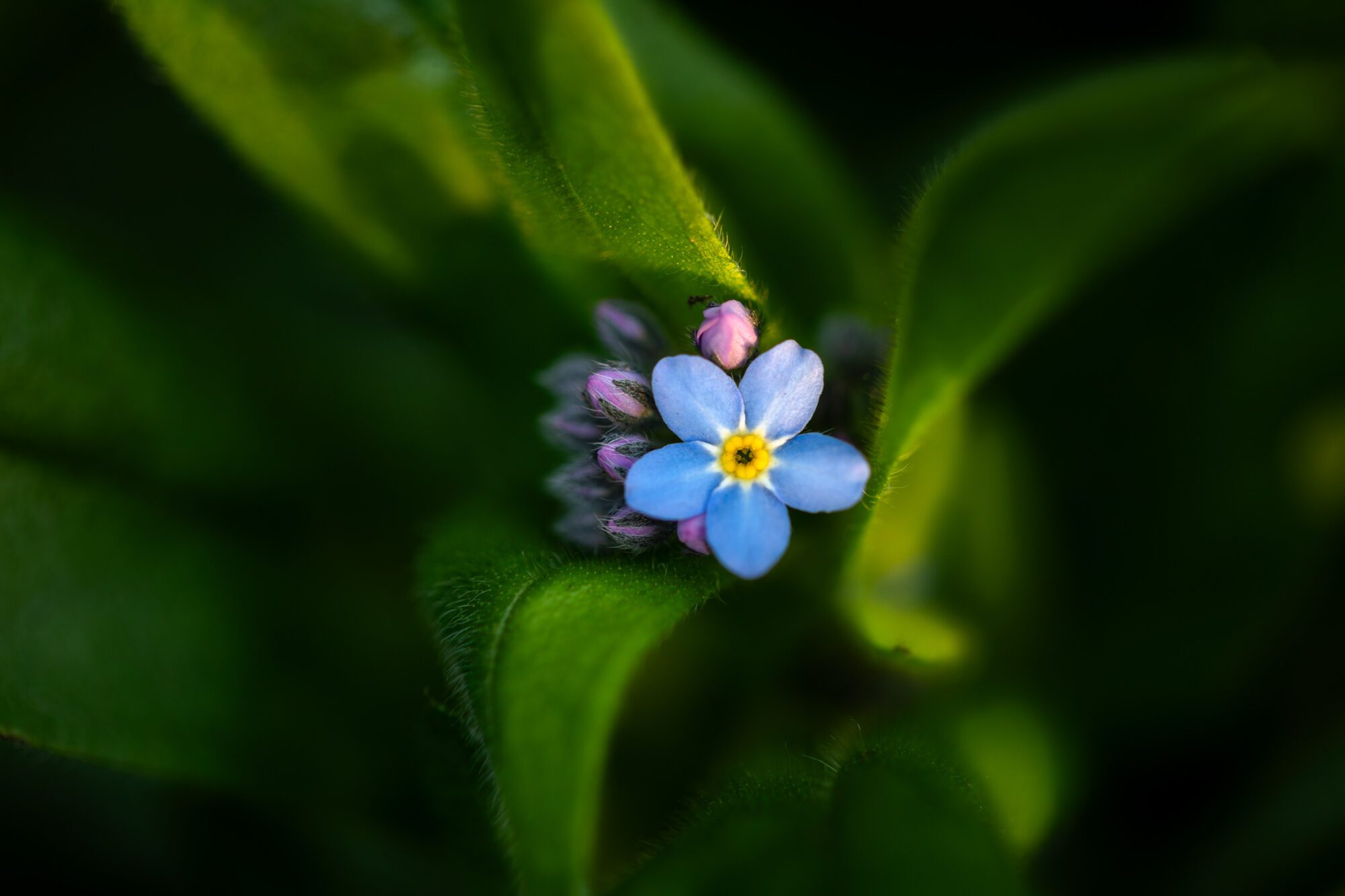Wildflower photography season is finally here. Spring is arguably one of the best seasons of the year for photography. As winter gives way to spring, subtle changes in the landscape begin to take hold. The days grow longer, the nights shorter, and new life begins to thrive. Vibrant colours emerge from the once-dormant landscape in the form of wildflowers. Delicately beautiful and true icons of spring, wildflowers are an absolute pleasure to photograph.
With these simple tips and techniques, you will be perfectly equipped to enjoy the very best of wildflower photography.

A favourite from last spring, a single flower standing proud amongst an abundance of Wild Garlic.
Wildflower Photography Code of Conduct
Before we discuss the tips and tricks for tackling wildflower photography, it’s worth familiarising yourself with the Wildflower Code of Conduct. Many of the UK’s wildflowers are protected by law, which makes it an offence to uproot, trample, or deliberately damage protected plants. Generally speaking, as photographers, we have a duty of care to protect the environment and the beautiful subjects we photograph.
We can protect wildflowers and the environment in which they thrive by adhering to the following:
- Follow and remain on designated paths if available
- Try to avoid or minimise ‘gardening’ the area around your subject(s)
- Adhere to land rules, particularly for SSSIs (Sites of Special Scientific Interest) and National Parks
- Leave no trace
You can read more about the official Wildflower Code of Conduct by visiting the link below.
Now that you’re familiar with the code of conduct, let’s take a look at the tips and tricks for wildflower photography.
The Best Light for Wildflower Photography
First and foremost, let’s talk light. Light is an essential component of any photograph and should be one of your primary considerations. The best times of day to photograph wildflowers are dawn and dusk, when the light is soft and more diffused. You will want to avoid harsh light and deep shadows, synonymous with midday light.
There is an exception, however; overcast days can provide exceptional light for wildflower photography as the clouds act as a giant natural diffuser. Well-diffused light during overcast days can produce delicately soft, painterly-looking images.
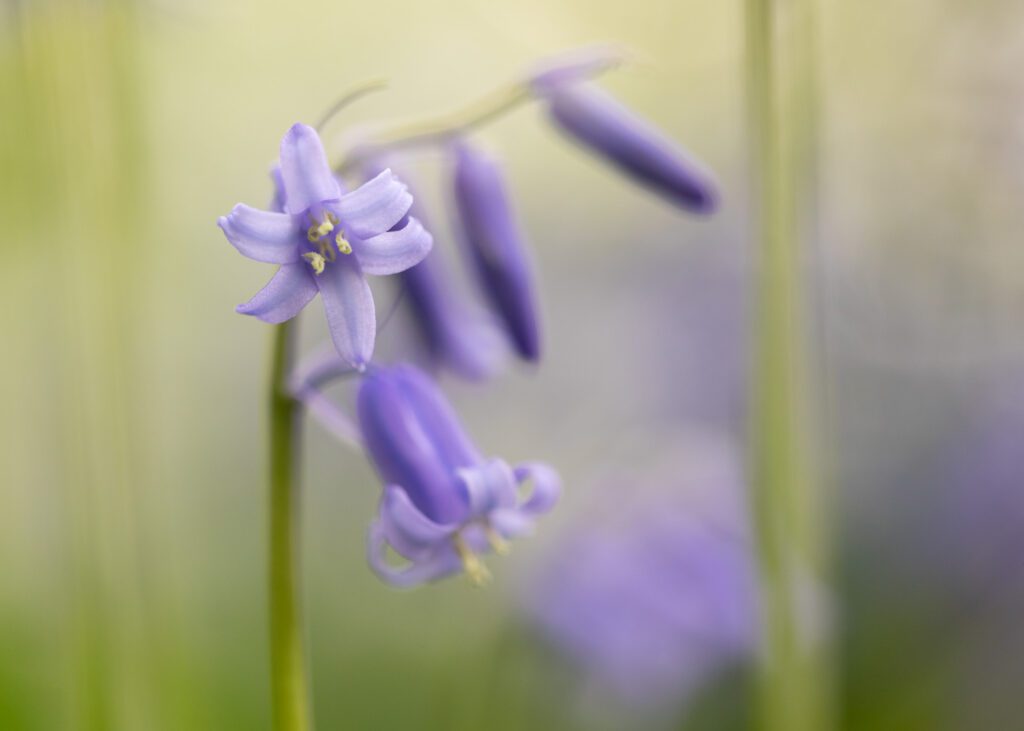
A beautiful flower stands proud as it matures in an abundance of Bluebells. Delicate soft light provided the perfect opportunity to capture this iconic flower at its best. It doesn’t get any better!
Beautiful golden hour light illuminating your background can help to add contrast and separation between your subject and the surroundings. Dappled light created by surrounding trees and undergrowth can also help add an interesting dynamic to your photographs.
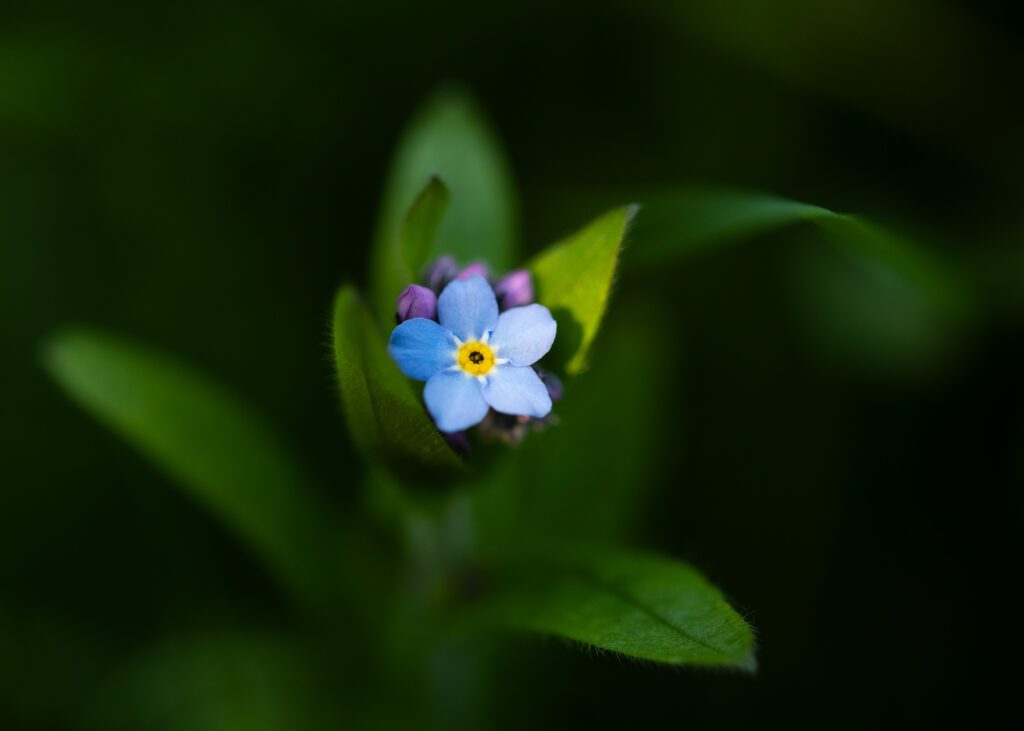
Woodland forget-me-not. This image was captured during sunset as the stunning light was broken up by overhanging tree branches, creating a dappled light effect.
Simplify Your Compositions
We’ve all been there, finding a beautiful subject in a somewhat chaotic environment. That’s the beauty of wildflower photography. Sometimes, you have to work hard to simplify your scene to isolate your subject while preserving the important elements. To help tackle this problem, you can ask yourself a series of questions.
- What is my main subject?
- Which features am I trying to illustrate?
- What would I like to include and/or exclude from the composition?
- Have I considered all available angles?
- Does time of day have an impact on the scene?
By working through questions such as the above, you can begin to refine and simplify your composition methodically. The advantage of this is that you can ensure that your subject is prominent and supported by the elements you consider essential to the scene.
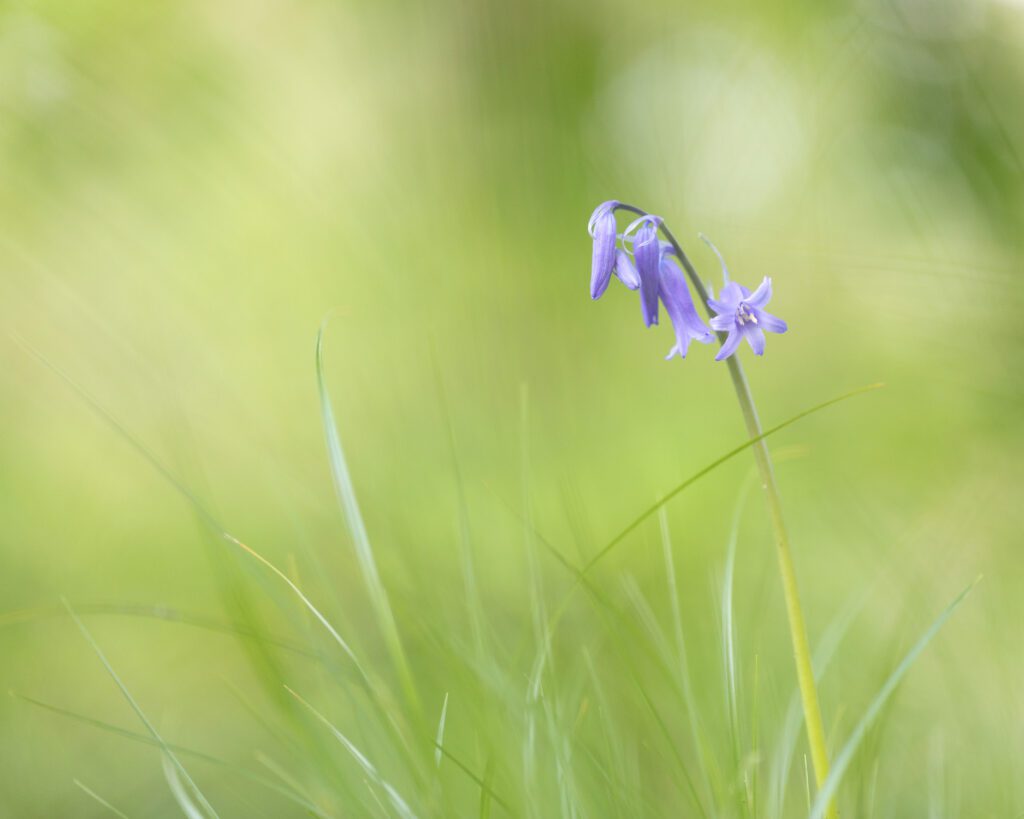
Inside a woodland with an abundance of Bluebells competing for space and sunlight, an outlier thrives. Standing tall amongst a patch of wild grasses, the first of its delicate flowers opens, marking the beginning of a new generation.
Applying the Simplification Process
Using the above image as an example, I will walk you through my thought process.
Bluebells are a beautifully iconic flower, but they can be tricky to photograph as they typically grow in large, sometimes chaotic clusters. I wanted to illustrate calm and space in a competitive environment. I scouted my local woodland daily, looking for potential subjects that met the criteria. After many hours of searching, I came across the perfect scene. A rogue Bluebell, an outlier, thriving amongst some wild grasses. I now had my story, the perfect subject, and I knew exactly what I wanted to include and exclude from the composition.
All that was left was the time of day. Now, this all comes down to personal preference, but for this image in particular, I wanted to capture my subject with delicately soft light. My reasoning was to add to the isolation and somewhat vulnerable look I wanted to achieve. Knowing this, it was simply a case of waiting for the ideal weather, overcast during a late afternoon. Piecing this together, I captured the image above and couldn’t have been happier with the result.
Lens Choices for Wildflower Photography
Choosing the right lens for the job can play a significant role in simplifying your compositions. For example, consider your subject is located on the edge of an unkept woodland. You have several elements you would like to exclude and have very little space to manoeuvre. Your go-to solution for this case could be a telephoto lens and/or a dedicated macro lens. Every lens category has unique benefits for wildflower photography and can add value to your images. Let’s briefly take a look at a few popular choices and the benefits they offer.
Macro Lenses
Macro lenses are my go-to for wildflower photography. A dedicated macro lens has a much smaller minimum focus distance, allowing you to hone in on your subject. Compared to conventional lenses, macro lenses offer far superior reproduction ratios of at least 1:1. A reproduction ratio of 1:1 means that the image captured on the sensor is the same size as your actual subject, allowing for unbelievably detailed photographs. For wildflower photography, a macro lens with a focal length of at least 100mm is a perfect starting point and won’t cost you an arm and a leg!
Canon’s EF 100mm F2.8L Macro is a phenomenal lens for wildflower photography. When used wide-open at F2.8, the lens is fast to focus with minimal hunting, incredibly sharp, and produces extremely pleasing bokeh.

The unmistakable smell of Wild Garlic is one of spring’s delights. Wild Garlic is an absolute pleasure to photograph with a macro lens, providing the opportunity to create painterly and intriguing photographs.
Telephoto Lenses
Telephoto lenses are an invaluable tool in your arsenal, especially for wildflower photography. They can help to simplify your compositions by allowing you to get closer to your subject. Telephoto lenses also add visual compression to your images, particularly with longer focal lengths. This can be used creatively to make backgrounds appear closer to your subject than they actually are. Furthermore, a telephoto lens with a wide aperture (such as F2.8) can create a pleasing bokeh effect to complement your subject(s).
Wide-Angle Lenses
Wide-angle lenses are perfect for capturing the bigger picture, literally and figuratively. A wide-angle lens can prove invaluable when photographing landscapes with a definitive foreground (for this guide, we’ll assume wildflowers), midground, and background elements. By getting low and close to your chosen wildflowers, you can include them as a dominant foreground element, making for a pleasing lead through your composition.
A few examples of wide-angle photographs in which wildflowers play a significant role within the composition.
Experiment with Different Perspectives
When framing and composing your wildflower photographs, consider different perspectives. Generally, you will want to photograph the flower head-on, but some rules are made to be broken. Thinking outside the box can lead to more unique and creative shots.
Get Down Low
Consider getting down low and shooting upwards towards your subject. A wide range of wildflowers grow low to the ground, and so by lowering yourself to their level, you can obtain more of a POV-type shot. This works exceptionally well with sunrise and sunset. Positioning the sun behind your subject whilst it is low to the horizon can create an extremely pleasing silhouette effect. To make life more comfortable, you can make use of a cushion or soft pads for your elbows if you know you are likely to be at ground level for extended periods of time.
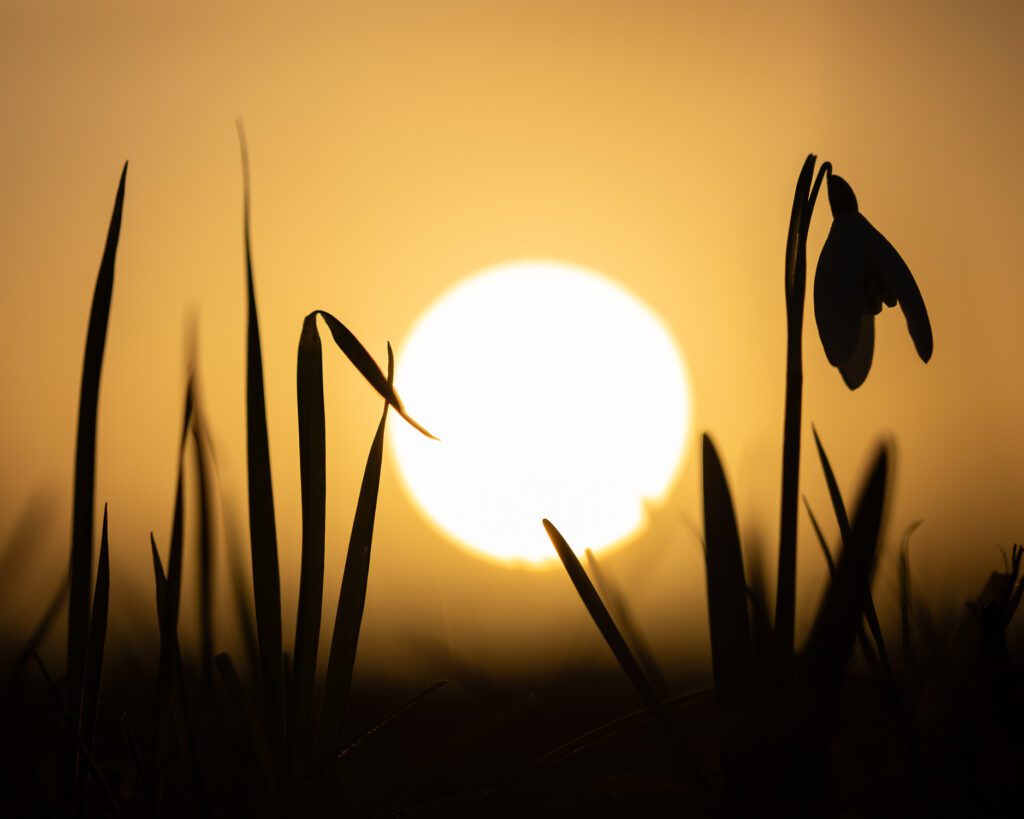
An early emerging Snowdrop from earlier this year stands proud as the warm winter sun gently approaches the horizon.
Look Down
Some species of wildflowers, such as the Woodland Forget-me-not, benefit from being photographed from above. It’s not always the case, but for the most part, their flowers open towards the sky. If you catch them early enough, you can use their leaves as leading lines for a pleasing top-down photograph.
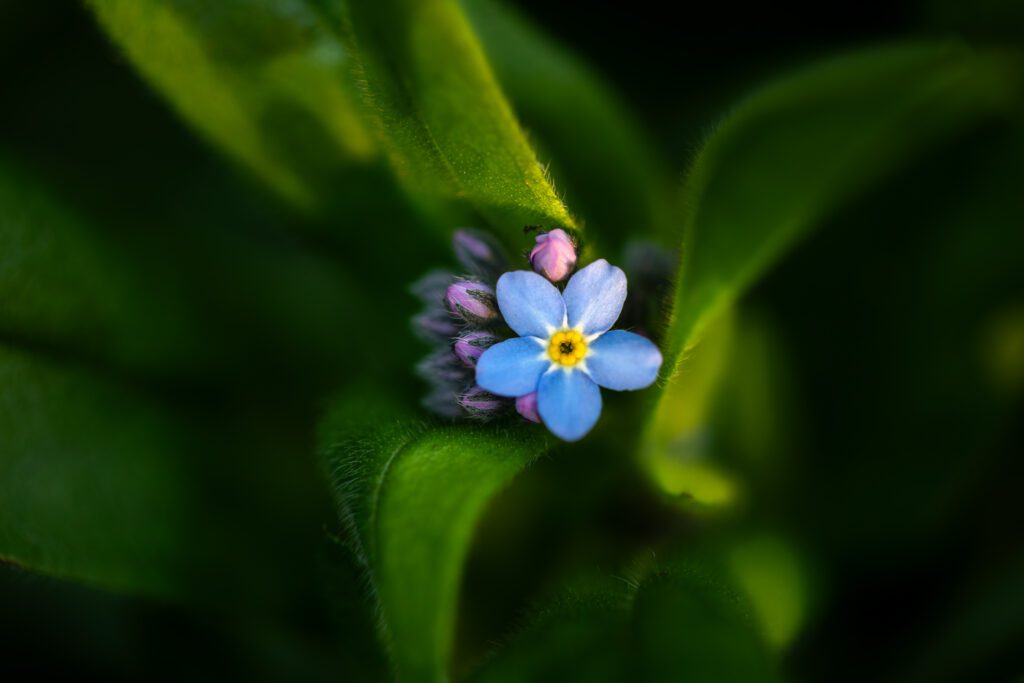
Woodland Forget-me-nots are one of our most abundant wildflowers, making them the perfect subject to hone your wildflower photography skills. Looking down towards newly emerging flowers is a delightful way to photograph these beautiful wildflowers.
Alternate Angles
Experimenting with different angles can illustrate your subject from a unique perspective. Wildflowers such as the Greater Stitchwort can be photographed from close to 45 degrees without losing visibility of the stamen. When combined with a wide aperture lens, alternate angles can help to add depth to your images. By manoeuvring to a more favourable angle, you can include soft-focused surrounding flowers in the foreground and background of your compositions.
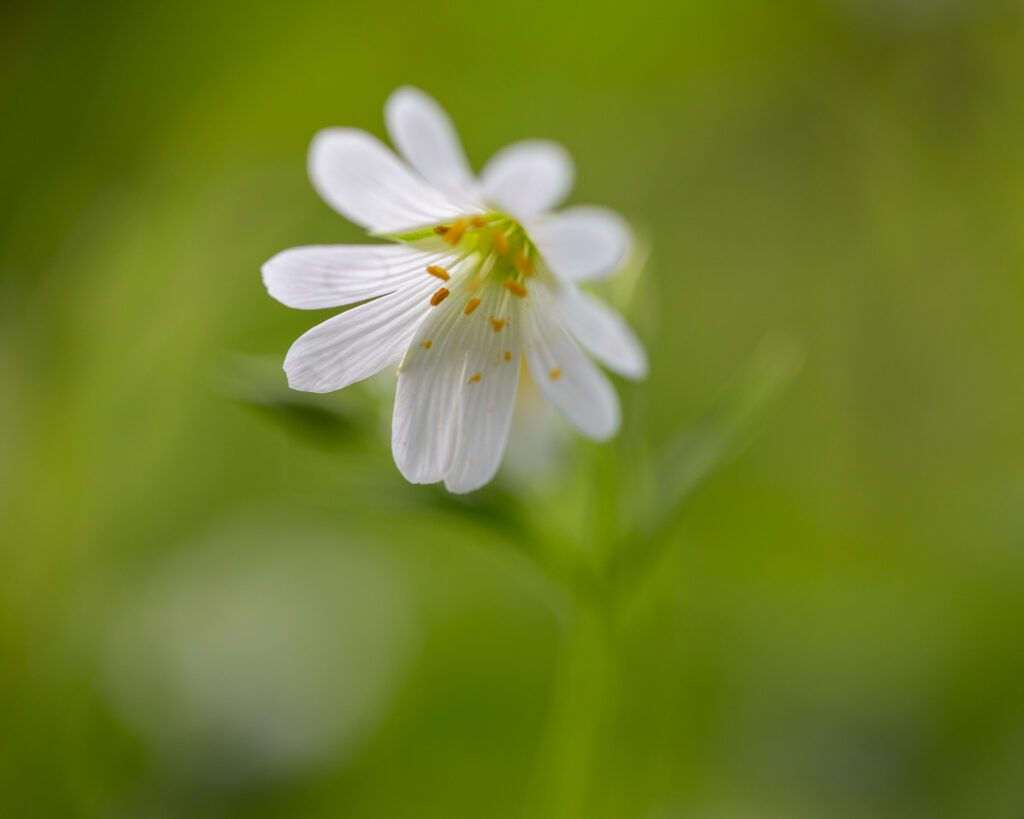
Greater stitchwort is a delicately beautiful spring wildflower that can prove a challenge to photograph. The reward is worth it, though, but be quick! Their flowers don’t last long, and so your scene can change dramatically from one day to the next.
Metering Modes
For the most part, evaluative metering will be your go-to metering mode for wildflower photography. However, from time to time, you will encounter conditions requiring you to give your camera a helping hand with metering.
High dynamic range conditions, creating a significant contrast between your subject and background, can cause havoc with your camera’s metering. If you were to photograph a scene under a high-dynamic range, your histogram would likely have deep shadows and extreme highlights. Luckily, you can give your camera a helping hand by adopting an alternative metering mode called “spot metering”.
By analysing a small percentage of the frame area (typically the centre focus point), spot metering allows your camera to ignore everything except for the important area, your subject. With practice, you will soon master back-lit scenes and produce unique and captivating images.
Summary
Spring is a phenomenal time of year for photography. Get outside and enjoy yourself. You don’t have to travel far to find an abundance of beautiful wildflowers to photograph. Wildflowers can be found in local parks, woodlands, nature reserves and wild open fields. Scout along the edges of woodlands and amongst large unkept fields, and it won’t be long before you find an abundance of beautiful subjects.
Practice, Practice, Practice!
Practice makes perfect, and when it comes to wildflower photography, no two days are ever the same. Environments and the weather are both incredibly dynamic, giving you plenty of room for creative freedom. Find a location you like and visit often. Build a portfolio of images illustrating growth and maturity as spring progresses.
Simplify Your Compositions
Simplify your wildflower compositions to highlight your subject. Wide apertures (such as F2.8 and lower) can help remove distractions caused by cluttered backgrounds, replacing them with a pleasing bokeh effect. For backlit and high-dynamic scenes, consider using spot metering to help guide your camera to correct exposures.
Protect Our Wildflowers!
Finally, obey the Wildflower Code of Conduct! As nature photographers, we have a duty of care to the environment. No photograph should ever be captured at the expense of harming nature and/or the landscape.
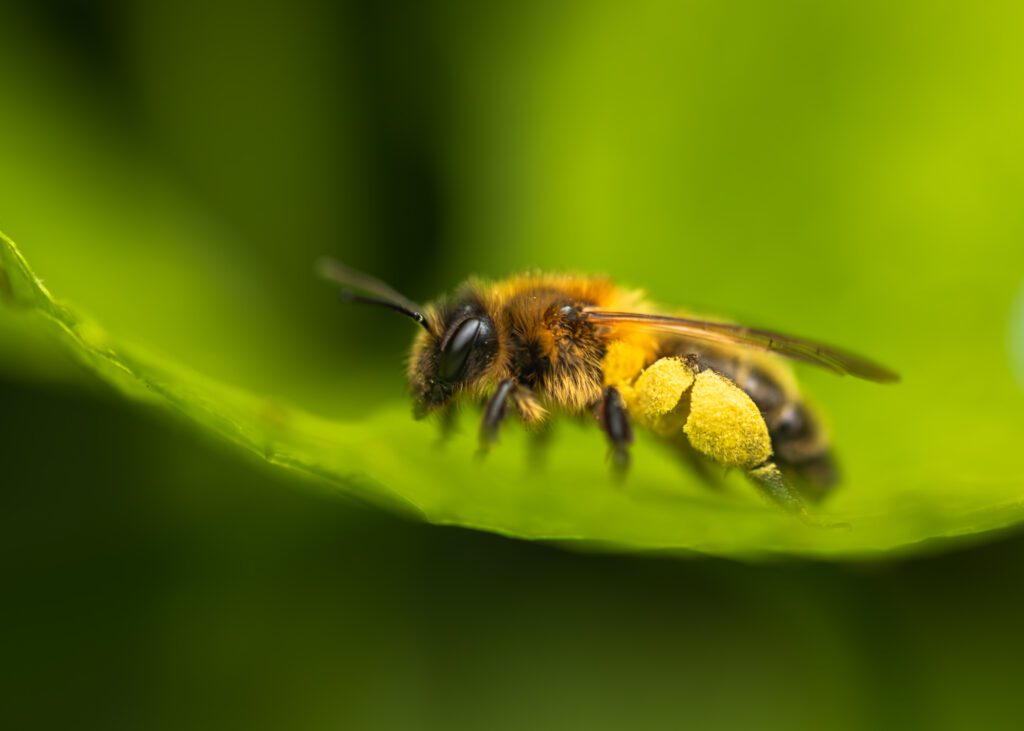
Here’s a bonus photograph featuring one of nature’s most iconic heroes, the Honey Bee. This beautiful character was enjoying a well-earned rest on a newly emerged Beech tree leaf after a productive morning’s work collecting pollen.
Thanks for reading! I hope you found this guide insightful and that it answers any questions you may have had about wildflower photography. If you would like to know more about any of the topics covered, please don’t hesitate to contact me via the link below.

